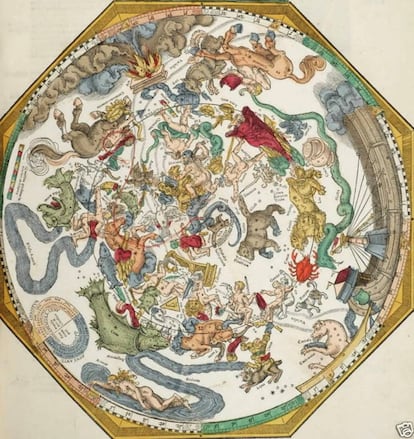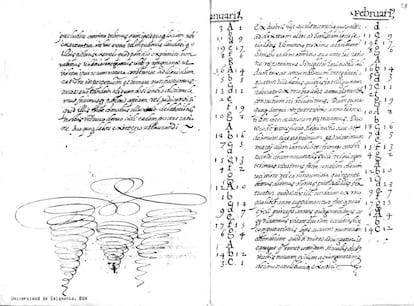Upset at losing an hour from Daylight Saving Time? Just imagine losing 10 days
When the Roman-era calendar was adjusted to the solar year, subjects of the Spanish Empire went to bed on Thursday, October 4, 1582, and woke up on Friday, October 15


Current coronavirus confinement measures have probably dampened the controversy over changing the clocks, a practice that could be eliminated by 2021 if a proposal backed by the European Parliament is adopted.
Daylight Saving Time, which went into effect last weekend, may put our internal clocks out of sync for a few days. But this change is really insignificant in comparison to what happened to people living on the Iberian Peninsula in 1582.
That was the year that they went to bed on Thursday, October 4, and woke up on Friday, October 15. Ten entire days had been wiped out just like that.
It’s not that King Philip II’s subjects spent 10 days sleeping, or woke up wondering who had stolen a third of the month of October from them.
In the year 325, the Church of Rome established that Easter should be celebrated separately from the Jewish Passover
Instead, the missing days were due to the fact that Catholic Europe had decided to end a mismatch between the real year – the one measured by a full orbit of the Earth around the Sun – and the one measured by the calendars of the period. And it happened that Salamanca University played a leading role in the adjustment, which meant 10 days being knocked out of existence.
The Earth does not take exactly 365 days to go around the Sun. The Julian calendar, proposed by Julius Caesar in 46 BC, took this into consideration and calculated that each year lasted 365 days plus a quarter of a day, which was fixed by establishing a leap year every four years.
Even so, the Julian calendar remained out of sync by approximately 11 minutes and 14 seconds a year, which accumulated over a period of 128 years made up an entire day, so that over time the calendar was becoming increasingly out of date.
At the meeting of the First Council of Nicaea (in modern-day Turkey) in the year 325, the Church of Rome established that Easter should be celebrated separately from the Jewish Passover. Until then, the shifting date of Easter for Christians had been a source of amusement to both pagan peoples and the Jewish, who were experts at measuring time.

The Church agreed that it should always be celebrated on the Sunday following the full moon after the spring equinox. If it coincided with the Jewish Passover, the Christian celebration would be on the following Sunday. “That same council established that the equinox be moved to March 21, the date to which the astronomical equinox had been brought forward from the traditional Roman world’s March 25, although the Feast of the Annunciation, nine months before Christmas, continued to be celebrated on the 25th,” explains Juan Antonio Belmonte, a research professor at the Canaries Astrophysics Institute and an expert in archeoastronomy, which explores how ancient people studied the skies.
As the gap in the Julian calendar increased over the years, the spring equinox came increasingly early, and the date for Easter stopped making sense. It was believed that Christ’s resurrection coincided with the beginning of spring’s lighter, warmer days and the idea of nature coming back to life, but the celebrations were being pushed further and further into the cold winter.
The Salamanca solution
For centuries, the experts racked their brains and devised calendars that would best suit the solar year, as described in the book Salamanca y la medida del tiempo (or, Salamanca and the Measuring of Time) by Ana María Carabias Torres, a lecturer of modern history at the University of Salamanca. But none of them came up with a convincing solution that would reconcile human time with the year as defined by the skies.
In 1515, Pope Leo X and King Ferdinand the Catholic asked the University of Salamanca, as well as other universities and scholars, for a report on how to adjust the calendar. The Salamanca scholars calculated that the difference between the calendar and real time was a little more than 10 days, and proposed to remove 11 days from a month. Another proposal involved eliminating leap days over a period of 44 years, which would mean a more gradual adjustment without any sudden jump in dates. The equinox would return to March 21, and serve as reference for setting the dates of the major Christian feasts, while Christ’s resurrection would always be celebrated in early spring.
With a view to the future, the University of Salamanca also proposed a new system, which would omit one leap day every 152 years. “A refined and unusual astronomical calculation,” says Carabias. “It’s perhaps Salamanca’s most important mathematical contribution, because no one had ever proposed such a precise measurement before.”

However, their proposal was forgotten. “The question of dates was so controversial that every ecumenical council held a commission to match up the calendar,” says Carabias. At the Trent Council held between 1545 and 1563, no agreement was reached either, but as the supreme authority, the Pope was urged to adopt a solution.
That is why in 1578, Pope Gregory XIII asked for new reports from the great centers of learning in Europe, including Salamanca University, which reminded the Pontiff that they had already sent in a proposal in 1515. “The individual who supposedly discovered the solution was an Italian, Aloys Lilio, but my theory is that he copied the report that Salamanca had proposed in 1515,” says Carabias. “In fact, when Lilio calculated the dates for Easter, the Salamanca scholars commented that even a minor mathematician could have come up with them. We owe the calendar used by the immense majority of humanity today to the University of Salamanca.”
That proposal was taken on board by Gregory XIII, whose papal bull of February 24, 1582 imposed the Gregorian calendar on the entire Christian world. King Philip II of Spain, who ruled over “an empire on which the sun never sets,” introduced it on September 29, and it was thus that all of his subjects went from October 4 to October 15 literally from one day to the next.
According to Carabias, October 4 was chosen for the leap in time because October was a month of few religious celebrations that could easily be dispensed with. Even so, the change brought with it a few problems, such as the fact that the martiniega or St Martin’s tax, which was collected from the subjects of the Crown of Castile on November 11 to coincide with Martinmas, was collected 10 days earlier that year.
Globalization
According to Carabias, the Gregorian calendar has been of the utmost significance in the history of globalization. “Its imposition transformed the world, or at least redirected it towards a global project, since present-day history and civil life are governed by this calendar.”
Although the adjustment of dates was abrupt, it was several centuries before the new calendar was almost universally adopted, with territories ruled by Catholic monarchs being the first to make the switch. “In France, where there had been religious freedom since Henry IV, Protestants also had to follow it, because the decision was made by the king, who was a Catholic,” says Carabias.
Subsequently, countries with Protestant rulers also accepted it, the last of these being England in 1752. By then the Julian calendar was already another day behind, and British subjects on both sides of the pond went to bed on September 2 and woke up on September 14.
The Gregorian calendar was adopted by Japan in 1873 and by imperial China in 1912, while Russia took it on board in 1918 and Turkey in 1927.
The current calendar is not perfect, but to an extent it follows the criteria established by the University of Salamanca in 1515, as the manner of eliminating the extra days is slightly different from the one adopted in 1578: a second is added to a day every few years, so that clocks and calendars can be synchronized with the rotation of the Earth, which measures the days, which in turn can be synchronized with the movement of the Earth around the Sun, which measures the years.
English version by Heather Galloway
Tu suscripción se está usando en otro dispositivo
¿Quieres añadir otro usuario a tu suscripción?
Si continúas leyendo en este dispositivo, no se podrá leer en el otro.
FlechaTu suscripción se está usando en otro dispositivo y solo puedes acceder a EL PAÍS desde un dispositivo a la vez.
Si quieres compartir tu cuenta, cambia tu suscripción a la modalidad Premium, así podrás añadir otro usuario. Cada uno accederá con su propia cuenta de email, lo que os permitirá personalizar vuestra experiencia en EL PAÍS.
¿Tienes una suscripción de empresa? Accede aquí para contratar más cuentas.
En el caso de no saber quién está usando tu cuenta, te recomendamos cambiar tu contraseña aquí.
Si decides continuar compartiendo tu cuenta, este mensaje se mostrará en tu dispositivo y en el de la otra persona que está usando tu cuenta de forma indefinida, afectando a tu experiencia de lectura. Puedes consultar aquí los términos y condiciones de la suscripción digital.
More information
Últimas noticias
Mexico’s missing people crisis casts a shadow over World Cup venue
Can cheese protect brain health? This is what the science says
ICE raids trigger school absenteeism and traumatize children: ‘They have been forced to leave their childhood behind’
Families demand repatriation of bodies of Colombians who died in Ukraine: ‘This war is a slaughterhouse for foreigners’
Most viewed
- Christian Louboutin: ‘Young people don’t want to be like their parents. And if their parents wear sneakers, they’re going to look for something else’
- US sanctions against jailed cartel leader ‘El Marro’ highlight Mexico’s lack of control over its prisons
- Cartels in Mexico take a leap forward with narco-drones: ‘It is criminal groups that are leading the innovation race’
- Liset Menéndez de la Prida, neuroscientist: ‘It’s not normal to constantly seek pleasure; it’s important to be bored, to be calm’
- ‘El Limones’ and the growing union disguise of Mexican organized crime










































